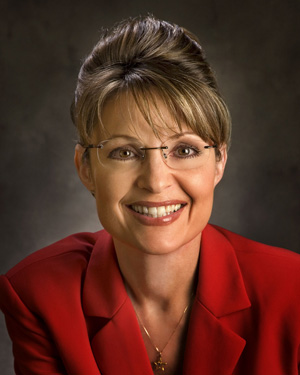
Alaska
Governor
Sarah Palin
12/4/2006 - ? |
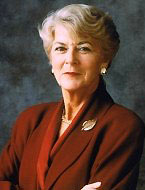
Congresswoman
Geraldine
Ferraro
1/3/79 – 1/3/85 |

Commissioner
Katharine
Bement Davis
1914 & 1915 |
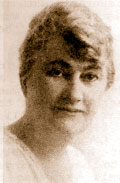
Workhouse
Superintendent
Mary M. Lilly
1919 - 1928 |
©Foursome of Ticket Firsts:
Sarah Palin, Geraldine Ferraro . . . .
Katharine Bement Davis? Mary M. Lilly?
-- Chapter V |
'Women Owe No One Party for the Vote'
 | | KBD image from Ch. 15 of Correction's Katharine Bement Davis:
NYC's Suffragist Commissioner on this website. The caption reads:
"Dr. Davis poses, resting her hands on the back of a straight chair, in this formal photo for the Bureau of Social Hygiene (Photo courtesy of Special Collections, Vassar College Libraries, Poughkeepsie, N.Y.)." Click to access.
|
On Dec.1, 1917, national, state and city woman suffrage leaders held a luncheon, in part, celebrating the NY amendment adoption. The next day the Times, under the headline SAY WOMEN OWE VOTE TO NO PARTY, reported:
Miss Mary Garrett Hay, Chairman of
the Woman Suffrage Party of the City
of New York, was the guest of honor at
a thanksgiving luncheon given by her
co-workers for suffrage at the Hotel
Astor yesterday. Leaders of the
suffrage movement, national, state, and
local, gave to Miss Hay a large share
of credit for their victory on Nov. 6.
Miss Hay told her audience that she
had access to the official election
returns, not yet published, and that she
could assure them that they owed their
success to no one political party. She
said that a study of the vote for
suffrage and for the mayoralty candidates
showed that the votes which won the
ballot for women came from all parties. . . .
In accepting the gift, Miss Hay told
the suffrage workers that “no one
party gave us the vote, and when politicians approach you and ask you not
to forget 'the party that gave you the
vote' just smile. We are not beholden
to any one party, and it is our duty to
make all parties what they ought to be."
Dr. Katharine B. Davis said she would
like to see the suffrage organization
kept intact to carry on a campaign of
education among the women voters.
She said she would be sorry to see
women line up on one side of political
questions and men on the other. In
concluding she said:
"I don't know that Miss Hay will ever want to run for public office, but I
do know that there isn't an office in the
gift of the people that Miss Hay isn't
competent to fill.”
Mrs. Norman de R. Whitehouse,
Chairman of the New York State
Suffrage Party, speaking of the suffrage
victory, said: “We did it,” and
notified the suffragists they owed nothing
to any one of the political parties. . . . .
NY State Voting Rights Win Sped 19th Amendment
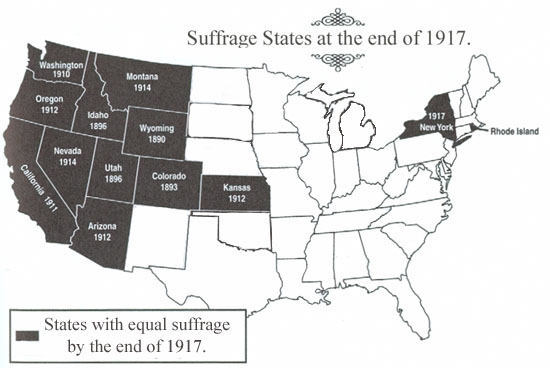 To better appreciate the strategic significance of the victory won by Miss Hay, Mrs. de R. Whitehouse, Dr. Davis and all the other suffragists who campaigned for adoption of the NY state suffrage amendment, one need only look to the nearby map showing the country's equal suffrage states as of Dec. 31, 1917.
To better appreciate the strategic significance of the victory won by Miss Hay, Mrs. de R. Whitehouse, Dr. Davis and all the other suffragists who campaigned for adoption of the NY state suffrage amendment, one need only look to the nearby map showing the country's equal suffrage states as of Dec. 31, 1917.
Prior to 1917, the nation had 11 equal suffrage states, all of them west of the Mississippi. In 1917, those 11 were joined by the first two states on the East Coast, tiny Rhode Island and New York which then -- as it had been since 1820 -- ranked first among all states in terms of population, and therefore also in the size of its Congressional delegation.
The History of Woman Suffrage, by Stanton, Anthony, Gage, and Harper, alluded to this aspect:
. . . the four years of continuous campaign had resulted in final victory for New York State, the stronghold of opposition, the key to a Federal Suffrage Amendment because of its large representation and power in Congress. . . .
New York State's muscle in the House of Representative played its part in moving the so-called Susan B. Anthony Constitutional Amendment to the floor for a vote. There on Jan. 1918, it received exactly the two-thirds vote necessary for passage. But in the Senate on Oct. 1, it fell two votes shy of the required two-thirds. Again in 1919, the proposed 19th Amendment came up on the floor for action by the House. It was overwhelmingly approved, 304 to 89, on May 20. The Senate provided the necessary two-thirds approval June 5, sending it to the state legislatures for ratification.
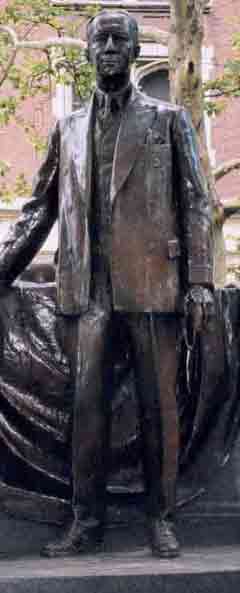 | |
Image of the bronze statue of Gov. Alfred Emanuel Smith appears on NYC Parks & Recreation website. The statue stands in Alfred E. Smith Park on Catherine St. in the Lower East Side neighborhood where he was born.
Click to access.
|
DOCer/Assemblywoman Helps Ratify
U.S. Suffrage Amendment
On June 16. 1919, at a special session of the legislature in Albany, called up by Democrat Gov. Al Smith to expedite the ratification process, the Assembly voted approval of the suffrage amendment first. It passed 137 to 0.
To mark the occasion appropriately, Speaker Thaddeus C. Sweet, Republican, chose to include -- despite lack of seniority -- the first female members of the State Legislature -- in the Assembly delegation designated to deliver formal notification to the State Senate of the Assembly's action and of its readiness to adjourn.
New York State's first lady lawmakers were Republican Ida Sammis of Huntington, a Suffolk suffrage leader, and Democrat Mary M. Lilly of NYC, an attorney and a DOC superintendent of women inmates. Both were included as speakers on behalf of ratification in the carefully choreographed script that presented an appearance of unity on the issue. But that imagery didn't stop the lawmakers on both sides of the aisle from claiming their party, not the other party, deserved more credit for gaining equal suffrage. Ratification was adopted unanimously in the Assembly.
According to the Times next day story (6/17/19) on the special session, when those two Assemblywomen entered the chamber of the still all-male State Senate, the pair was greeted with applause from many Senators at their desks and from suffragists in the gallery.
Close to midnight, the Senate voted 40 to 0 for ratification, making New York the sixth state to do so.
Fourteen months later Tennessee would become the 36th state to ratify it, satisfying the federal requirement for ratification by three-fourths of the states in order for a proposed amendment to be added to the Constitution.
Mrs. Lilly: Wife, Mother, Widow, School Teacher & Administrator, Lawyer, Club Woman, Editor, Legislator, Penologist
Frequently in reviewing historical movements, such as the struggle for woman suffrage, some of the individuals involved are mentioned only briefly and only in terms of their connection to the cause being considered. Limitations of both available text space and reader attention spans combine to make such brevity a necessity. Yet, unfortunately, that often results in the reader having a sense of being presented with a series of one-dimensional cutouts inserted into assigned slots in a cardboard historical tableau.
 | |
Hunter College began in 1869 as a combined high school and "normal school" -- that is, a teachers college for females from 14 years and up. In 1914, it was renamed in honor of Thomas Hunter, its first president.
Click for its beginning history on the Hunter High School Alumnae Association website.
|
Mary M. Lilly's life, so very multi-faceted, defies being reduced to any single dimension. Not a cutout character, nor easily slotted, she.
The widow of John F. Lilly, she was the mother of J. Joseph Lilly who also would have a note-worthy legal career, including public service as a NYC assistant corporation counsel and an assistant U.S. Attorney for the Southern District of NY.
Mrs. Lilly graduated Hunter College teachers school in 1876 while still in her teens and taught classes in P.S. 37, Manhattan, later becoming its acting principal. While still teaching, she attended NYU law school on a full scholarship that she won as a result of taking a competitive exam, reportedly the first such grant ever won by a woman.
Even after earning her law degree in 1895 at age 35, Mrs. Lilly continued teaching for some years but, having devoted decades to the school system, eventually retired from it to concentrate on her career as an attorney. She did what many lawyers do when starting their practice: she networked. The long list of organizations in which Mary was active included:
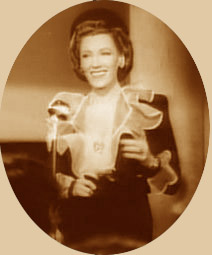 | |
Entertainer Helen Menken, above, was a niece of Assemblywoman/Superintendent Mary M. Lilly. Helen was the daughter of German-French father, Frederick Meinken and an Irish-born mother, Mary Madden, Mrs. Lilly's sister. The image is based on a still photo of Miss Menken from the 1943 film Stage Door Canteen in which she played herself, a popular and critically acclaimed stage actress. Mostly a stage performer, Helen appeared in musicials as well as dramas, playing in casts with such actors as Basil Rathbone, John Drew, Judith Anderson and Helen Hayes. Humphrey Bogart and Miss Menken married early in 1926 but divorced late in 1927, a first marriage for each.
|
The Association of Retired Teachers of the
City of New York of which she was secretary.
- The NYC Federation of Women's Clubs, of which she was recording secretary. As chairman of the federation's Probation Committee, she became involved in its efforts to establish a detention facility (aka house of refuge) just for female first offenders in Brooklyn.
- The Women Lawyers Association, with she served as editor of its Journal.
- A participant in the July 19-22 conference in Seneca Fall sponsored by the Women's Party to commemorate the Women's Rights Convention of 1848;
- The Society for the Aid to Mental Defectives, with which she served as editor of its Journal.
- The Kickerbocker Civic League, of which she was a founder and had served as its president.
- The Women's Democratic Club with which she often served as a member of committees involved in arranging social and political events.
- Women's Civic Organization, with which she was active on several of its committees. It seemed the civic version of the Women's Democratic Club. Throughout the 1920s, whenever the NYC Democratic Party or its women's civic entity held a major social event, it enlisted Mrs. Lilly. Whether the occasion involved a would-be or actual President, Governor or Mayor, the party (both with a capital "P" and lower case "p") turned to her.

| |
Image of Women's Night Court scene from Rheta Childe Dorr's What eight million women want, a Project Gutenberg volume. Click to access. |
For a period of time, she and another lady lawyer, Eve P. Radtke, who had been admitted to the bar in 1906, shared an office and law practice.
Mrs. Lilly's Interaction With
Anna Moskowitz Kross
Both Mary M. Lilly and Anna Moscowitz Kross were leaders in the Women's Lawyers Association that had evolved from the Women's Lawyers Club organized June 24, 1899. On that date, 25 lady lawyers met in the law office of Miss Edith J. Griswald in the St. Paul Building, 220 Broadway, Manhattan. It was believed the first such organization of its kind in the country.
In 1915, Mrs. Lilly and Miss Anna Moskowitz were among six members of the Women's Lawyers Association who volunteered to serve as counsel to the female defendants brought into Women's Night Court.
On Oct. 21, 1922, Mrs. Lilly (then a DOC Workhouse superintendent) and Mrs. Anna M. Kross (a future Correction Commissioner), were among the listed speakers at the Women's Democratic Club's luncheon in the Hotel Commodore "greeting" the party's slate of candidates.
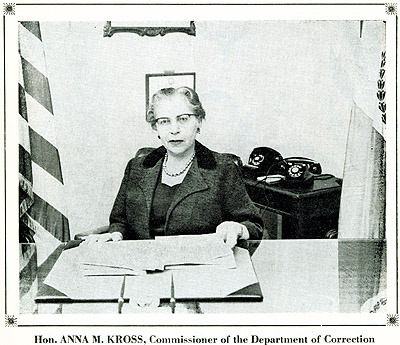 |
Image of Correction Commissioner Anna M. Kross appearing
in many of her more than two dozen annual reports.
|
Both Mrs. Lilly and Mrs. Kross were active in the Women's Civic Organization formed in January 1926. They participated in a luncheon at the Hotel Commodore the following March 20 in honor of Mrs. James J. Walker, the mayor's wife, at which Gov. Al Smith spoke.
On Oct. 14 that same year Mrs. Lilly was among the listed "patronesses" of its dinner dance at the Hotel Astor honoring the governor's wife.
In 1924, NYC and the Democratic Party in NY played host to the party's national convention. Both Mrs. Lilly and Mrs. Ann M. Kross were among those tapped to be members of the convention reception committee.
Her 1 Year as Assemblywoman Seen by Supporters as Effective
NYC's first woman state lawmaker, Mary M. Lilly, served only a single one-year term (1919) in the Assembly. Not until 1938 was the Assembly member term extended to two years, with elections being held in even-numbered years.
 | | NYC's first Assemblywoman Mary M. Lilly strongly supported beautification and preservation of
Riverside Park, where the Eleanor Roosevelt Monument (above) was erected in 1996 ceremonies attended by then First Lady and now Senator Hillary Rodham Clinton, who in 2008 came close to winning the Democratic Presidential nomination. For more about the park and statue, click the statue's image from the Parks Department website. |
Despite the fact that the Democrats were in the minority in the Assembly during 1919 and the fact that she was only a "freshman" legislator, Mary Lilly was credited by supporters with putting to good use her legal skills and her organizational know-how from years of club work, becoming quite an effective lawmaker in the process.
She was reported to have played a role in the eventual passage of the law creating the rank of policewoman equivalent to policeman. The Police Matron’s Association had lobbied for the legislation giving Police Matrons the title of Policewoman. The legislature enacted the measure.
She also was said to have pushed legislation - to shut down the noxious Riverside Drive dumping grounds;
- to mandate mufflers on motor boats;
- for establishing paternity of children born out-of-wedlock;
- to abolish the death penalty;
- to protect children's rights; and
- to give preference in employment upon public works to honorably discharged New York veterans.
Appointed to DOC on Memorable Day in NY Suffrage History
In June 1919, Assemblywoman Lilly received notice that she had placed first on a civil service exam that she had taken in 1917 for the Department of Correction position of female inmates director (superintendent). That test date was before the state suffrage amendment had been approved, before the Democrats nominated her to run for the 7th A.D. seat, and before she won the election.
 | | Image of old Blackwell's Island workhouse, built in 1857, is from
the Correctional Photograph Archives Collection on the Eastern Kentucky University website. Click to access this excellent resource for Correction History.
|
James A. Hamilton, Correction Commissioner in Mayor John F. Hylan's administration, invited her to accept appointment to the position. Although he could have chosen any one of the top few on the civil service exam list for the post, he decide to go with No. 1 and indicated he wanted her for the job.
After consulting with outside counsel who advised her that it would be legal for her to do so, the Assemblywoman accepted appointment. The formal date of her city civil service appointment turned out to have been the same day the Assembly and State Senate ratified the Susan B. Anthony 19th Amendment to the U.S. Constitution and then adjourned.
She thereafter served with DOC for about a decade.
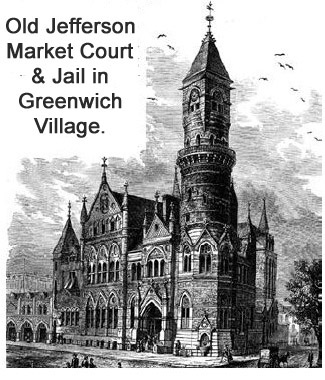 Perhaps an insight into her personal integrity can be gleaned from her outspokenness in a State Prison Commission report condemning a 1921 situation that the city jail system faced after overnight detentions in the Jefferson Market Prison were ended in July of that year due to the unsanitary conditions of its cells.
Perhaps an insight into her personal integrity can be gleaned from her outspokenness in a State Prison Commission report condemning a 1921 situation that the city jail system faced after overnight detentions in the Jefferson Market Prison were ended in July of that year due to the unsanitary conditions of its cells.
Unarraigned or unbailed female first offense defendants were being brought to the Workhouse (Detention House) on Welfare Island, and transported back and forth to the Women's Court in Manhattan, with little or no facilities available to segregate them properly from hardened convicted recidivists.
The report quoted Superintendent Lilly flatly declaring, according to the Times Dec. 11, 1921 story:
"Without going into further details, the whole system is a bad one and merits severe condemnation as unworthy of the great City of New York."
Lilly Re-election Bid Hit on Election Eve
Although she had been "on the job" with DOC for months, not until Nov. 2, 1919, did the Citizen Union -- which earlier had endorsed her Republican opponent -- issue a public statement that, in effect, challenged the legality of her being a municipal employee while also being a member of the state Assembly.

| |
Image of the NYS Assembly chamber comes from that legislative body's website page detailing the chamber's history. Click to access. The image of Assemblywoman Lilly at the top of each web page in this NYCHS presentation is also from the Assembly's website.
|
Quotations from the CU statement included in the Times story (Nov. 3, 1919) set forth her having been appointed June 16 as Director of Women Prisoners on Blackwell's Island at an annual salary of $2,100.
Members of Assembly, whose legislative session in that era almost invariably ended in April, and by May at the latest, were paid a salary of $1,500.
The statement quotations also included excerpts from sections of the State Constitution and the City Charter against holding "office" in state and city governments at the same time.
Assemblywoman/Superintendent Lilly quickly issued a response printed on Election Day in attempt to make clear
- that her DOC appointment as Workhouse Director had come through a competitive civil service exam,
- that she had taken the exam three years earlier, well before New York women acquired state suffrage and before she had been nominated and elected,
- that a municipal employee was not a "public officer" within the meaning of the relevant statutes,
- that her job with DOC was not a "public office" as envisioned by the charter and constitution sections cited, and
- that counsel had so advised her prior to her accepting the appointment.
Mrs. Lilly noted that as a DOC superintendent she was an employee carrying out policies set by the Commissioner; she didn't set them herself. Nor, she added, were her duties set by statute; they were set by the Commissioner.
"There is," she state,"all the difference in the world between a public office and a public employment . . . ."
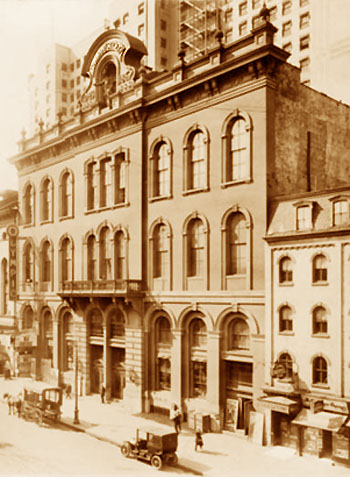
| |
Image of Tammany Hall is based on one in National Park Service Historic American Buildings Survey collection.
|
The Citizen Union had begun in 1897 as an anti-Tammany Hall political party.
After about a decade as an independent or third party, it stopped running candidates of its own or letting other party candidates run on its line in Fusion campaigns.
Even so, it remained true to its anti-Tammany traditions.
CU -- with its long record of dedicated service to the city, to the cause of voter education, and to the reform of politics and government -- is one of the finest civic betterment organizations of New York. Whether issuance of that statement on election eve 1919 would be counted among its finest hours is a question happily beyond the scope of this essay.
Whether the election eve statement played a decisive part in her not winning return to the Assembly is unclear.
It certainly didn't help, given that her district had been Republican traditionally.

Commissioner
James A.
Hamilton |

Commissioner
Frederick
Wallis |

Commissioner
Richard
Patterson | | Three commissionerships in which Superintendent Lilly served. |
Mrs. Lilly won it by only 174 votes in 1918 when she defeated Republican Abram Ellenbogen, a Harvard educated attorney seeking his 5th term in the Assembly.
The 1919 election results limited her service in the Assembly to the single one-year term. But Mrs. Lilly continued as DOC's women inmates superintendent for about a decade, serving under three different Commissioners: James A. Hamilton, Frederick A. Wallis and Richard C. Patterson. She retired in 1928 at age 68.
After a four-month illness Mrs. Lilly died Oct. 11, 1930, at the home of her son, on East 19th St., Brooklyn. Her residence was many years had been at the Hotel St. Andrew.
Mrs. Lilly's Interaction With Katharine Bement Davis
Given their involvement in women's club work, penal reform and political action, one wonders how often they encountered each other: Katharine Bement Davis, the NYC's first woman commissioner and the first woman ever to run as a statewide candidate on a major party in NYS, and Mary M. Lilly, the first NYC woman elected to the NYS Assembly.
When the lady lawyer Lilly took that female inmates superintendency civil service exam in 1917, former Correction Commissioner Davis was into her second year chairing the NYC Parole Commission. KBD was also working for passage the state suffrage amendment. Their common interest in its adoption could have brought them into contact with each other.
When Mrs. Lilly was working on various social issues as a lawmaker and/or dealing with social issues directly as a female inmates superintendent, Dr. Davis was heading the Rockefeller-funded Bureau of Social Hygiene. An early 20th century think-tank, the bureau during KBD's 10-year tenure as its general secretary was involved in such studies as Women Police and Dr. Edith Spaulding's Experimental Study of Psychopathic Delinquent Women. Both of those bureau projects came within Lilly's areas of interest.
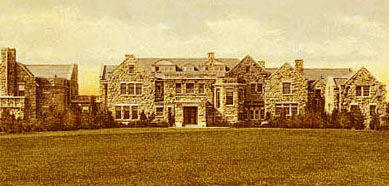
| |
The estate of philanthropist Adolph Lewisohn in Ardsley, Westchester, where Superintendent Lilly and former Commissioner Davis, attended presentation of a medal by the National Committee on Prisons and Prison Labor former Commissioner Lewis in 1925.
|
Given that two such highly-educated, widely-networked and multi-accomplished women go-getters as Davis and Lilly -- having the same or very similar fields of interest -- were active in the same civic and political arenas in the same town at the same time, they were bound to encounter each other occasionally.
But the odds did not favor their developing from those occasions a long-term continuing interaction, give their different political orientations and affinities.
 | |
Sing Sing Warden Lewis E. Lawes, formerly superintendent of NYC's Reformatory first on Hart Island and later in Orange County, NY, also attended 1925 medal ceremonies in Ardsley.
|
Davis was by family tradition a Republican, albeit a Teddy Roosevelt Progressive Republican; Lilly, a NYC Democratic Party stalwart.
We do know of at least one event both Davis and Lilly attended -- the May 23, 1925 presentation of medals to former NYC Correction Commissioner Burdette G. Lewis, then NJ Commissioner of Institutions and Agencies, and three others at a meeting in Ardsley, NY, of the National Committee on Prisons and Prison Labor devoted to promoting state-use-only prison industries.
Also among those attending the meeting at the estate of committee president, Adolph Lewisohn, were the then NYC Correction Commissioner Frederick A. Wallis; Sing Sing Warden Lewis E. Lawes, former NYC DOC reformatory superintendent under Davis and Lewis; and the then NYC DOC reformatory superintendent William A. Adams. The NYC Reformatory, that began on Hart island, relocated to New Hampton, Orange County, N.Y.
Also elected a member of the committee's board of directors, Commissioner Lewis was honored with the committee's medal for his securing the cooperation of the NJ Federation of Labor in developing prison industries in that state.
What Would Davis & Lilly Have Thought of the Collective Fact of
Ferraro, Clinton, & Palin Candidacies?
One is tempted to speculate what Davis and Lilly might have said to each other about the historic movement and moment they were part of, each in her own way -- the era of the emergence of women, not only casting political ballots, but also running on them.
One might even speculate what those two powerhouse women, both with New York Correction History ties, might say across the seeming divide of history to us in our own historic era.
Would they look at the candidacies for Vice President, President, and Vice President of three powerhouse women in our own time -- respectively, by a U.S. Representative and a U.S. Senator from New York, and the Governor of Alaska --  and smile to themselves and to each other, knowing their candidacies in their own time are part of this continuing story? and smile to themselves and to each other, knowing their candidacies in their own time are part of this continuing story?
Would they on their side of the seeming divide signal thumbs-up, not necessarily for any individual one of those candidacies in particular, but for the fact of those candidacies collectively?
Thomas C. McCarthy,
Webmaster
|
